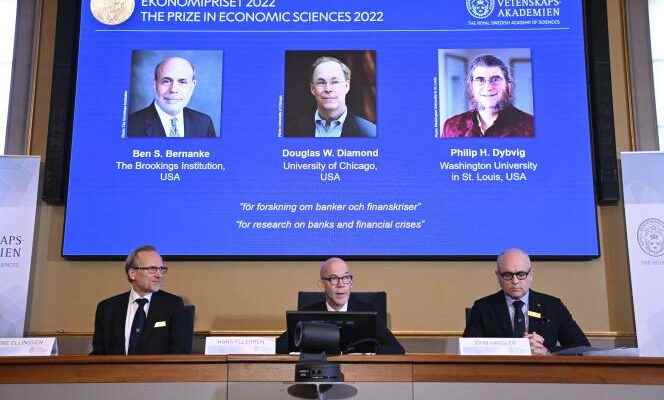Is this a sign of concern for the near future? The 2022 Bank of Sweden Prize in Tribute to Alfred Nobel has been awarded to Ben Bernanke, Douglas Diamond and Philip Dybvig, three specialists in financial crises, and more precisely in the major role that the fragilities of banks play in the severity of these crises .
Ben Bernanke is best known for having been the chairman of the American Federal Reserve (Fed) from 2006 to 2014, when he had to face the subprime crisis (2007-2008) by “rescuing” American banks with a deluge of redemptions securities and bond issues, the famous ” quantitative easing » (quantitative easing), quintupling the Fed’s balance sheet to $4 trillion. But it is not for this “exploit” – today controversial because it is suspected of having “leads to the current overheating and inflation”as Jean-Michel Naulot, a former member of the Autorité des marchés financiers, points out – that the economist is honored, but for his research on the history of the 1929 crisis.
“Banks are the nodes”
He has indeed shown that the main vehicle for the spread of the crisis in the real economy (bankruptcies, unemployment, Great Depression) after the initial financial “crash” of October is the cascade of bank closures ruined by the collapse of Wall Street. Indeed, explains Augustin Landier, professor of finance at HEC, “Banks are the nodes where information on economic agents, individuals and companies, is confronted. If they disappear, this information is no longer available and the economy no longer works until confidence is restored”. This demonstration by the academic Ben Bernanke, professor at Stanford, New York and Princeton, convinced the central banker Ben Bernanke that it was necessary, in order to curb the subprime crisis, of which he will admit in his Memoirs having initially underestimated the impact, “saving the banks”, whatever the cost – the shock caused by the bankruptcy of Lehman Brothers on September 15, 2008 had amply confirmed this.
For David Thesmar, professor of finance at MIT, Douglas Diamond and Philip Dybvig are themselves two “pure” theoreticians, one at the University of Chicago, the other at that of Saint-Louis. They are rewarded for an article that economists describe as “canonical” or “seminal”, published in… 1983 in the Journal of Political Economy, ” Bank Runs, Deposit Insurance and Liquidity ». This article indeed inaugurated a long list of research and publications by many of their colleagues on the fragilities of the banking system and the means to remedy them. Because the two economists have shown, when the rolling fire of the financialization of the economy is barely beginning, that the banks suffer from an intrinsic weakness, inscribed in the very nature of their activity: their liabilities (the deposits they collected from savers) is short-term – since savers can withdraw them at the first sign of loss of confidence – whereas their assets (investments and investments in corporate or government securities) are long-term.
You have 41.64% of this article left to read. The following is for subscribers only.
